Amazon Pay Fees: A Comprehensive Guide to Understanding the Costs Involved
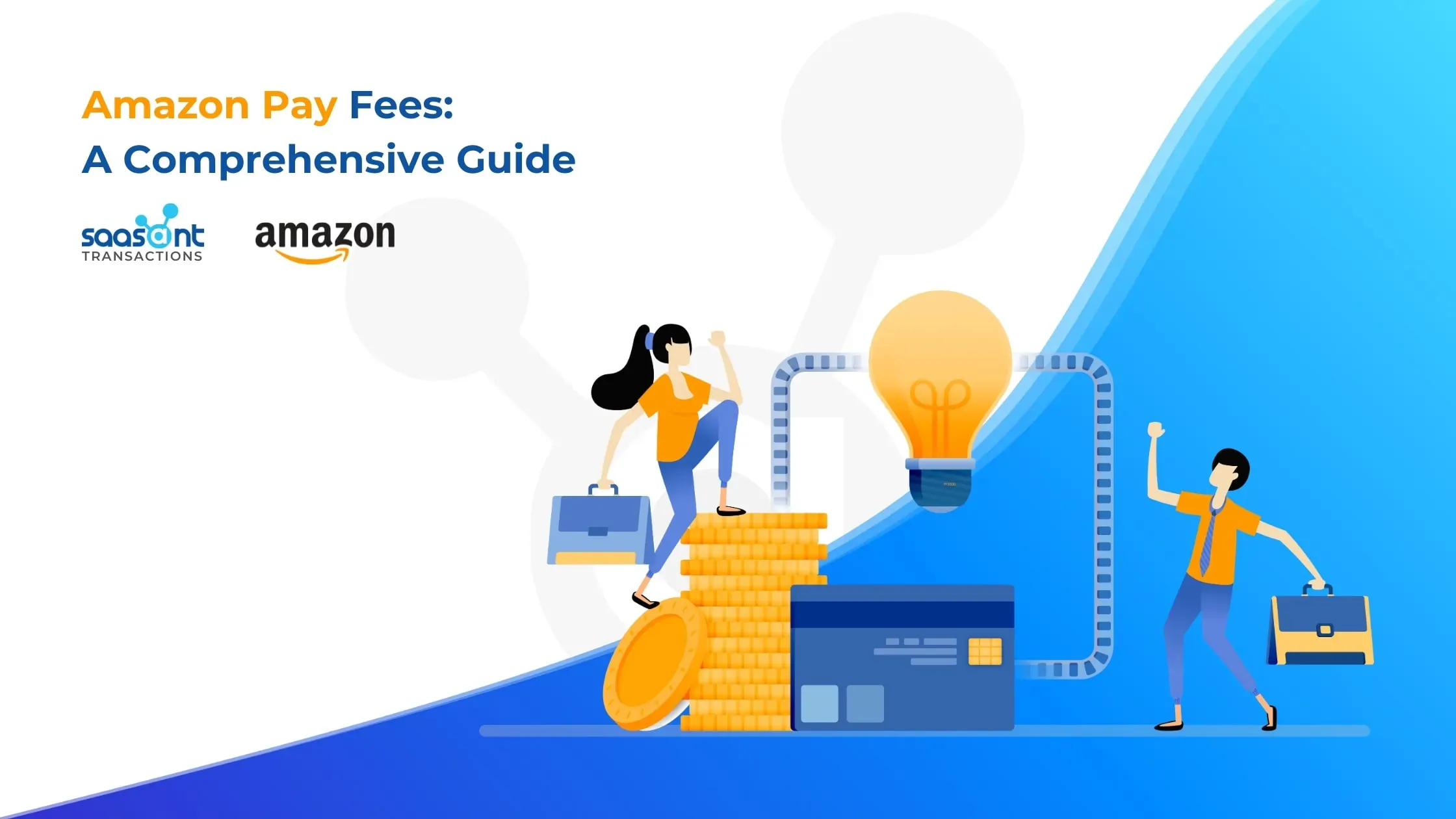
A survey done by Baymard Institute uncovered that 37% of customers leave a retail website due to the need to create yet another payment account, demonstrating shoppers' desire for convenience. Hence, the need for Amazon sellers to seek easy and fast checkout systems like Amazon Pay.
As an Amazon seller, you already know that Amazon Pay is a powerful payment system that can make online transactions a breeze for your customers. But do you know how much it costs you to use it? Understanding the fees associated with Amazon Pay is crucial for managing your finances and ensuring you are running a profitable business.
With over 300 million users worldwide, Amazon Pay is a widely used payment option that can help you reach more customers and grow your business. But with great power comes great responsibility - and in this case, that means staying on top of fees.
In this comprehensive guide, we'll dive deep into all the fees associated with Amazon Pay, from transaction fees and disputed chargeback fees to merchant fees and cross-border processing fees.
You'll learn everything you need to know to make informed decisions about using Amazon Pay for your business. So buckle up and get ready to master the ins and outs of Amazon Pay fees.
Contents
How Does Amazon Pay Work
How To Use Amazon Pay
Where Can I Use Amazon Pay
Amazon Pay Advantages and Disadvantages
What Fees Does Amazon Pay Take?
Do You Pay Credit Card Fees When You Use Amazon Pay
Can I Deposit Cash in Amazon Pay?
Amazon Pay Fees in US
Amazon Pay Fees in The UK
How to Determine Seller Fees for "Amazon Pay"
When Do I Have To Pay Amazon Seller Fees
What Happens If You Don’t Pay Seller Fees Amazon
Conclusion
FAQs
How Does Amazon Pay Work
Amazon Pay is a payment service offered by Amazon that allows customers to use their Amazon account to pay for goods and services on third-party websites. When a customer chooses to use Amazon Pay, they are redirected to a login page where they can log in with their Amazon account details.
Once the customer is logged in, they can complete their purchase without having to enter their payment or shipping information again. The payment is processed through Amazon Pay, and the funds are transferred from the customer's Amazon account to the merchant's account.
For merchants, using Amazon Pay means they can offer customers a trusted and familiar payment option, which can lead to increased sales and customer loyalty. Additionally, Amazon Pay provides merchants with access to Amazon's fraud detection and prevention tools, which can help mitigate the risk of fraudulent transactions.
How To Use Amazon Pay
Using Amazon Pay is not only convenient for customers, but it also offers benefits for merchants. By offering Amazon Pay as a payment option, merchants can reduce cart abandonment rates and increase customer satisfaction.
Using Amazon Pay is a simple and convenient way for customers to pay for goods and services online, and it's available to anyone with an Amazon account. Here's how to use Amazon Pay as an online customer:
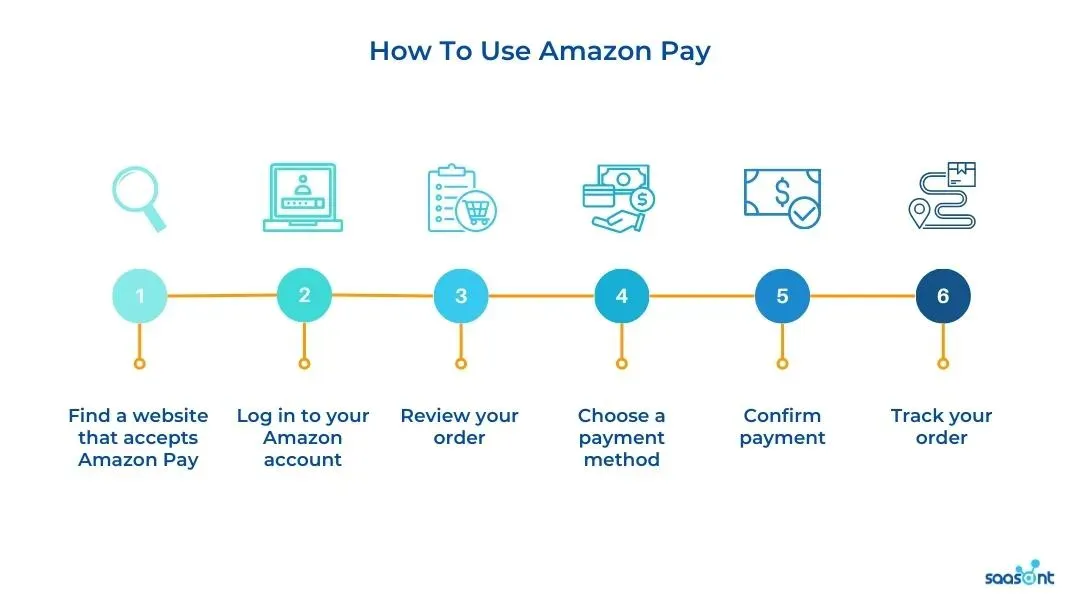
1. Find a website that accepts Amazon Pay: First, you need to find a selling platform that accepts Amazon Pay as a payment option. Look for the Amazon Pay logo or a "Pay with Amazon" button on the checkout page.
2. Log in to your Amazon account: When you're ready to pay, click on the Amazon Pay button or logo. You'll be redirected to the Amazon login page, where you'll need to enter your Amazon account details.
3. Review your order: After logging in, you'll be asked to review your order and shipping information to ensure everything is correct.
4. Choose a payment method: If you have multiple payment methods associated with your Amazon account, you'll need to choose one to use for this transaction. You can use your Amazon Pay balance, a credit or debit card, or a bank account.
5. Confirm payment: Once you've selected your payment method, review your order one last time and click on the "Place your order" button to confirm payment. You'll receive a confirmation email from Amazon with details about your transaction.
6. Track your order: You can track the status of your order on the merchant's website or through your Amazon account. If you have any issues with your order, you can contact the merchant or Amazon's customer service for assistance.
Where Can I Use Amazon Pay
Amazon Pay is accepted by a growing number of merchants and websites around the world. Here are some of the places where you can use Amazon Pay:
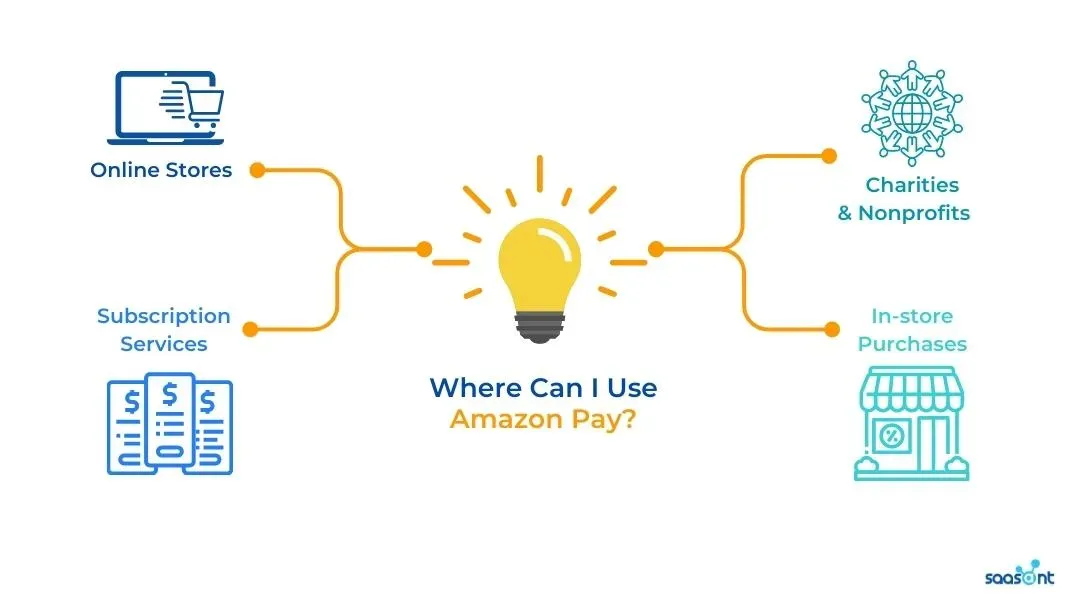
1. Online stores: Amazon Pay is accepted by a wide variety of online stores, including fashion retailers, electronics stores, and home goods retailers. An example of popular online stores that accept Amazon Pay is Zappos.
2. Subscription services: Many subscription-based services, such as streaming services, food delivery services, and online fitness programs, accept Amazon Pay as a payment option. An example of popular subscription services that accept Amazon Pay is Peloton.
3. Charities and nonprofits: Amazon Pay can also be used to make donations to charities and non-profit organizations. Some examples of organizations that accept Amazon Pay donations include St. Jude Children's Research Hospital and the American Red Cross.
4. In-store purchases: In addition to online purchases, Amazon Pay can also be used to make purchases in physical stores. Some merchants and select Amazon Go stores accept Amazon Pay as a payment option.
Amazon Pay is accepted by a wide range of merchants and websites, making it a convenient and flexible payment option for customers. You can find a list of merchants that accept Amazon Pay on the Amazon Pay website, or simply search for the distinctive Amazon Pay logo or “ Pay with Amazon” button on the page of your desired website.
Amazon Pay Advantages and Disadvantages
Amazon Pay is a popular payment service that offers several advantages and disadvantages to customers and merchants. Here are some of the key advantages and disadvantages of using Amazon Pay:
Advantages
Convenience: Amazon Pay is a convenient payment option for customers who already have an Amazon account, as it allows them to use their saved payment and shipping information without having to enter it again.
Security: Amazon Pay uses state-of-the-art security measures to protect customers' payment information, including encryption and fraud detection tools.
Dispute resolution: Amazon Pay offers dispute resolution services to customers, which can help resolve issues with merchants and protect customers from fraudulent transactions and chargebacks.
Trusted brand: Amazon is a well-known and trusted brand, which can give customers and merchants added peace of mind when using Amazon Pay.
Increased conversions: Merchants who offer Amazon Pay as a payment option may see increased conversions and lower cart abandonment rates, as customers are more likely to complete a purchase when they see a familiar and trusted payment option.
Disadvantages
Limited availability: Amazon Pay is not accepted by all merchants and websites, which can limit its usefulness for some customers.
Fees: Amazon Pay charges fees to merchants for each transaction, which can add up over time and may be passed on to customers through higher prices.
Limited payment options: While Amazon Pay offers several payment options, such as credit and debit cards and bank accounts, it may not be as flexible as other payment services that offer more payment options, such as PayPal.
Dependency on Amazon: Customers who use Amazon Pay may become too dependent on Amazon as a payment option and may be less likely to try other payment services or shop at merchants who do not offer Amazon Pay.
What Fees Does Amazon Pay Take?
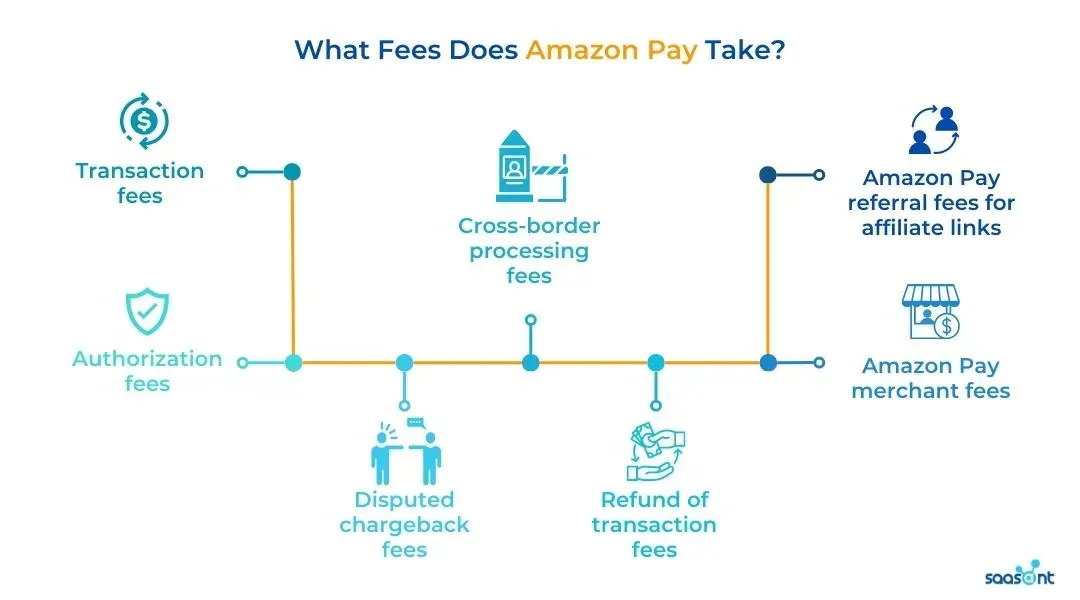
Amazon Pay charges several different fees to merchants and customers for each transaction. As a merchant, these costs must be factored into your bookkeeping as part of your expenses. Here is a breakdown of the fees that Amazon Pay takes:
Transaction fees
This fee is charged to both merchants for each transaction made using Amazon Pay. The transaction fee covers the costs of processing and settling the transaction.
For web and mobile transactions, the fee is typically 2.9% + $0.30 per transaction in the United States, but fees can vary depending on the region and currency in which the transaction takes place. For real-world goods or services using Alexa, the fee is typically 4% + $0.30 per transaction.
Authorization fees
This fee is charged when a transaction is authorized but not settled. The fee covers the costs of authorizing the transaction and ensuring that the customer has sufficient funds to complete the payment. For web and mobile transactions, the authorization fee is $0.30 per transaction. For real-world goods or services using Alexa, there is no authorization fee.
Disputed chargeback fees
This fee is charged if a customer disputes a charge and initiates a chargeback. In such cases, Amazon Pay charges a disputed chargeback fee of $20 per chargeback. However, this fee may be waived if the merchant wins the chargeback dispute.
Cross-border processing fees
This fee is charged if a merchant accepts payments from customers outside of their country or region. The cross-border processing fee covers the additional costs of processing cross-border transactions. For web and mobile transactions, the fee is typically 3.9% + $0.30 per transaction. For real-world goods or services using Alexa, the fee is typically 5% + $0.30 per transaction.
Refund of transaction fees
When a merchant issues a refund to a customer, the transaction fee is typically refunded to the merchant. However, the authorization fee is non-refundable.
Amazon Pay merchant fees
Amazon Pay merchant fees are charged to merchants for using Amazon Pay as a payment processor for their own products or services. These fees are typically based on the merchant's sales volume and can vary depending on the region and currency in which the sales take place.
Amazon Pay referral fees for affiliate links
If a merchant promotes their Amazon Pay link through an affiliate program, they may be charged a referral fee for each transaction made through the affiliate link. The referral fee varies depending on the affiliate program and can range from 8% to 15% of the transaction value.
Do You Pay Credit Card Fees When You Use Amazon Pay
When you use Amazon Pay to make a purchase, you have the option to pay using a credit card or a bank account. If you choose to pay with a credit card, you may wonder if you have to pay any credit card fees in addition to the fees charged by Amazon Pay.
The short answer is no, you do not have to pay any credit card fees when you use Amazon Pay. Amazon Pay itself does not charge any additional fees for using a credit card to make a purchase. However, the credit card company may charge a fee for the transaction, depending on their policies.
Credit card companies make money by charging merchants a processing fee for each transaction that is made using their credit cards. The fee is typically a percentage of the purchase amount, ranging from 1.5% to 3.5% depending on the credit card company and the type of card used. The merchant is responsible for paying this fee to the credit card company.
In the case of Amazon Pay, the merchant is the one who pays the transaction fee to the credit card company, not the customer. This means that when you use Amazon Pay to make a purchase, you do not have to pay any additional credit card fees beyond the purchase price and the fees charged by Amazon Pay.
However, it is worth noting that if you are a merchant who accepts payments through Amazon Pay, you will be responsible for paying the credit card processing fees for each transaction. These fees can add up over time and may cut into your profit margins.
To minimize the impact of credit card fees on your business, you may want to consider offering discounts to customers who pay with a bank account or other alternative payment methods that do not incur credit card processing fees.
You can also adjust your prices to factor in the cost of credit card fees, although this may make your prices less competitive compared to other merchants who do not pass on these fees to customers.
Conclusively, as a customer using Amazon Pay to make a purchase, you do not have to pay any additional credit card fees beyond the purchase price and the fees charged by Amazon Pay. However, if you are a merchant who accepts payments through Amazon Pay, you will be responsible for paying credit card processing fees for each transaction.
Amazon Pay Charges on Credit Card
As discussed earlier, Amazon Pay charges credit card processing fees, which are the fees charged by credit card companies for processing transactions. These fees vary depending on the credit card company and the type of credit card used.
For example, American Express charges a higher processing fee (2.5-3.5%) compared to Visa or Mastercard (1.5-2.5%). When a customer makes a purchase using Amazon Pay and pays with a credit card, the credit card processing fee is deducted from the transaction amount before it is credited to the seller's account. The amount deducted varies depending on the credit card company and the type of credit card used.
To give an example, if a customer makes a purchase of $100 using Amazon Pay and pays with an American Express credit card, and the credit card processing fee is 3%, then $3 will be deducted from the transaction amount as the credit card processing fee, leaving $97 as the amount that will be credited to the seller's account.
Can I Deposit Cash in Amazon Pay?
No, it is not possible to deposit cash in Amazon Pay. Amazon Pay is a digital payment service that allows customers to make online transactions using their credit or debit cards or bank accounts.
To add funds to your Amazon Pay account, you need to link a valid payment method, such as a credit or debit card or a bank account. Amazon Pay also allows you to store your payment and shipping information in one place, making it easier and more convenient to make purchases on Amazon and other third-party websites.
Additionally, Amazon Pay provides a secure and reliable payment system that ensures your personal and financial information is protected during transactions. If you need to make a cash payment for an Amazon purchase, you can use Amazon Cash.
This is a service that allows you to add cash to your Amazon account by visiting a participating retailer and presenting a barcode at the register. The funds will be instantly added to your Amazon account balance and can be used for future purchases.
What Are The Charges For Adding Money in Amazon Pay?
There are typically no charges for adding money to your Amazon Pay account. However, this may depend on the payment method you use to add funds to your account.
If you add money to your Amazon Pay account using a credit or debit card, there may be a fee associated with the transaction. For example, if you add funds using a credit card, you may be charged a cash advance fee by your card issuer.
Additionally, if you use a non-US credit or debit card to add funds, you may be charged a cross-border transaction fee by your bank. On the other hand, if you add funds to your Amazon Pay account using a bank account, there are usually no charges associated with the transaction.
However, you may need to verify your bank account information before you can add funds to your account. It's important to note that Amazon Pay may occasionally run promotions that offer cash back or other incentives for adding funds to your account.
These promotions typically have specific terms and conditions, such as a minimum amount you need to add to your account to qualify for the promotion.
Can I Add More Than $10,000 in Amazon Pay?
Yes, it is possible to add more than $10,000 to your Amazon Pay account. However, there may be some restrictions and additional verification requirements depending on the amount you want to add.
If you want to add a large amount to your account, Amazon Pay may require you to provide additional documentation to verify your identity and the source of the funds. This may include providing a copy of your ID, bank statements, or other documents.
Additionally, there may be limits on the amount you can add to your account per transaction or per day. These limits may vary depending on the payment method you use to add funds to your account, such as a credit card, debit card, or bank account.
It's important to note that adding a large amount of money to your Amazon Pay account may also have tax implications. If you are adding funds as part of a business transaction or for other business purposes, it's a good idea to consult with a tax professional to understand your obligations and any reporting requirements.
How to Load Amazon Pay with Your Credit Card
To load Amazon Pay with your credit card, you can follow these steps:
Go to the Amazon Pay page and log in to your account.
Click on the "Add Money" button.
Select the amount you want to add to your Amazon Pay balance.
Choose your credit card as the payment method.
Enter your credit card details such as the card number, expiry date, and CVV code.
Click on the "Add Your Card" button to proceed.
Verify the details of your credit card and the amount you want to add to your Amazon Pay balance.
Click on the "Continue" button to complete the transaction.
After completing the transaction, the amount you loaded will be added to your Amazon Pay balance, and you can use it to pay for your Amazon purchases or other transactions that accept Amazon Pay as a payment method.
Please note that there may be a minimum and maximum amount limit for adding money to your Amazon Pay balance using a credit card, and you should check with Amazon for any fees or charges associated with the transaction.
Amazon Pay Fees in US
Here's a table summarizing the fees charged by Amazon Pay in the United States:
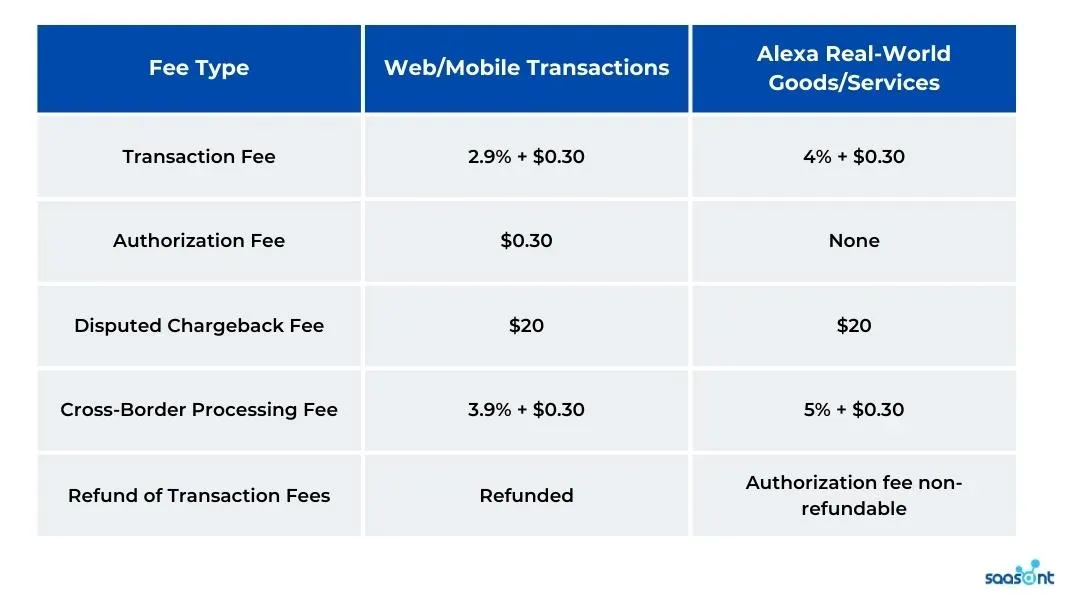
Note that these fees are subject to change and may vary depending on the region and currency used in the transaction.
Amazon Pay Fees in The UK
Here is a detailed summary of the Amazon Pay Fees in the UK:
1. Processing Fee: The percentage processing fee varies depending on the type of transaction and ranges from 1.4% to 3.4% for web/mobile transactions and 2.7% to 5.2% for Alexa (real-world goods and services) transactions.
2. Authorisation Fee: This fee is a fixed amount per authorisation request and varies depending on the currency of the transaction.
Below is a table showing the processing and authorisation fee obtainable in the UK:

3. Cross Border Fee: The fee is a percentage of the transaction amount and ranges from 0.4% to 1.5%, depending on the type of transaction.
Here is a table showing the cross border fee when payment is received from other countries to using Amazon Pay UK:

4. Currency Conversion Fee: This fee is charged for transactions where the currency of the transaction is not GBP. The fee is a percentage of the transaction amount and ranges from 0.5% to 4.5%, depending on the currency of the transaction.
5. Chargeback Dispute Fee: This fee is charged when a buyer disputes a transaction and the seller is unable to provide sufficient evidence to prove that the transaction was valid. The fee is a fixed amount per dispute and varies depending on the currency of the transaction. For transactions in GBP, the chargeback dispute fee is £14 per dispute.
How to Determine Seller Fees for "Amazon Pay"
Determining the seller fees for Amazon Pay depends on a variety of factors, including the location of the seller, the type of transaction, and the payment method used by the buyer. Here are some steps to help you determine your seller fees:
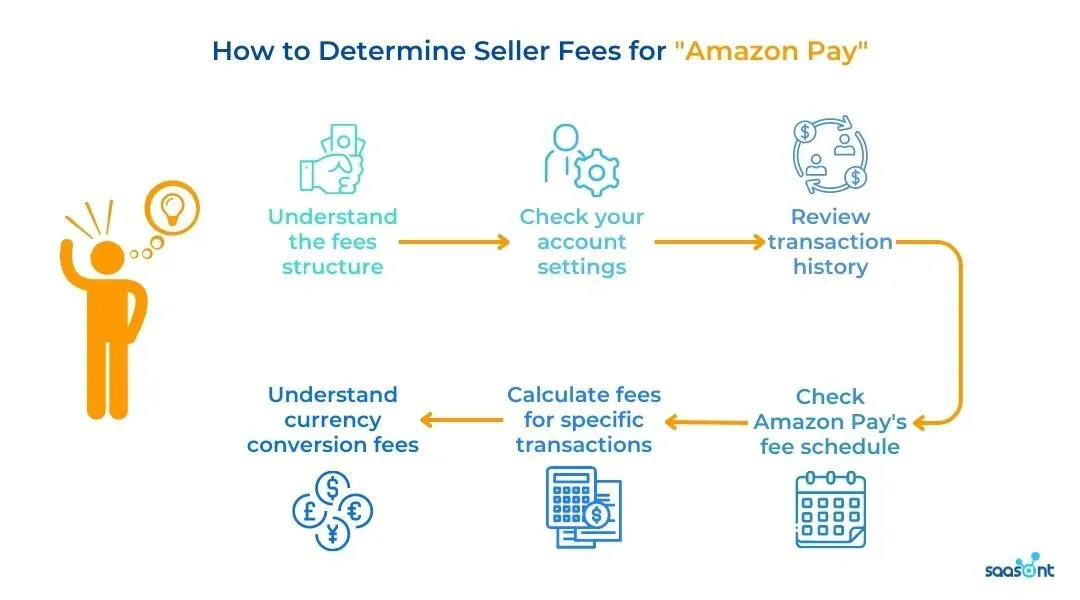
1. Understand the fees structure
Amazon Pay charges processing fees for all transactions made through its platform. These fees vary depending on the country where the seller is located and the type of transaction.
2. Check your account settings
Log in to your Amazon Pay account and navigate to the "Settings" section. Here, you can view your account information, payment methods, and other important details related to your account.
3. Review transaction history
Check your transaction history to see what fees you have been charged in the past. This can help you estimate what fees you can expect for future transactions.
4. Check Amazon Pay's fee schedule
Amazon Pay provides a fee schedule for each country where it operates. This fee schedule outlines the processing fees and other fees that sellers can expect to pay.
5. Calculate fees for specific transactions
To calculate fees for a specific transaction, you will need to know the transaction amount, the payment method used by the buyer, and the location of the buyer and seller. You can use Amazon Pay's fee calculator to estimate the fees for a particular transaction.
6. Understand currency conversion fees
If you are selling to customers in a different currency, Amazon Pay will charge a currency conversion fee. This fee is based on the exchange rate at the time of the transaction and is added to the processing fee.
When Do I Have To Pay Amazon Seller Fees
As an Amazon seller, you will have to pay your fees based on your chosen payment method and your selling plan.
For individual sellers, you will be charged a fee for each item sold on Amazon. These fees are typically deducted from the proceeds of the sale. If you are using Amazon Pay, the fees will be deducted from your account balance.
For professional sellers, you will have a monthly subscription fee as well as a referral fee and variable closing fees based on the category of the product you are selling. These fees are typically charged on a bi-weekly basis and are deducted from your available balance.
In both cases, you will need to ensure that you have sufficient funds in your account to cover the fees. Amazon will attempt to charge your credit card on file if your account balance is insufficient, but it is important to keep track of your account balance to avoid any negative consequences.
What Happens If You Don’t Pay Seller Fees Amazon
It is almost impossible for an Amazon seller not to pay their Amazon Pay fees because the deduction is made automatically by Amazon. However, it can happen if an empty bank account is linked to the Amazon account.
If a seller doesn't pay their Amazon seller fees, they risk having their account suspended or even terminated. When a seller's account is suspended, they won't be able to sell any products until they pay their outstanding balance.
Amazon may also take legal action against the seller to recover the unpaid fees, including hiring a collection agency or filing a lawsuit. Additionally, Amazon may report the delinquent account to credit bureaus, which could negatively impact the seller's credit score.
Conclusion
In addition to understanding the fees associated with Amazon Pay, it is also important for businesses to have an efficient and accurate way to track and manage their payment transactions. This is where PayTraQer comes in.
It is a powerful payment management platform that enables businesses to easily track, reconcile, and manage their payment transactions across multiple payment gateways, including Amazon Pay. With PayTraQer, businesses can streamline their payment operations and gain valuable insights into their payment processing data.
PayTraQer offers a user-friendly interface that allows businesses to track payment activity in real-time, automate payment reconciliation, and generate detailed reports for better decision-making. It also offers advanced security features to ensure that payment data is protected at all times.
By using PayTraQer integration with Amazon Pay, businesses can effectively manage their payment processing costs and optimize their payment operations. It is an essential tool for any business that relies on Amazon Pay and other payment gateways to drive revenue and grow their business.
FAQs
How do I login to Amazon Pay?
You can log in to Amazon Pay using your Amazon account information. Here are the steps:
1. Go to the Amazon Pay website (pay.amazon.com) or click on the Amazon Pay button on a participating merchant's website.
2. Click on the "Sign in with Amazon" button.
3. Enter your Amazon account email address and password, and then click "Sign In."
4. If you have two-step verification enabled on your Amazon account, you may be prompted to enter a verification code that will be sent to your phone or email address.
5. Once you've logged in, you'll be able to view your Amazon Pay balance, transaction history, and manage your payment methods.
Alternatively, you can also access Amazon Pay from your Amazon account dashboard. Simply go to your account settings and click on the "Amazon Pay" option to log in.
Does Amazon Pay charge a fee?
Yes, Amazon Pay charges a processing fee on each transaction made through their payment gateway. The fee structure may vary depending on the country and the type of transaction. It's important to review the fee structure carefully before using Amazon Pay to ensure you understand the costs involved.
Does Amazon Pay have a minimum balance?
No, Amazon Pay does not have a minimum balance requirement. You can use your Amazon Pay account for transactions regardless of the amount available in your balance. However, you must have a sufficient balance or payment method linked to your account to cover the cost of the transaction you want to make.
If you don't have enough funds in your Amazon Pay balance, the remaining amount will be charged to your linked payment method.
What are the annual fees of Amazon Pay Later?
Amazon Pay Later is a service that allows eligible customers to make purchases on Amazon and pay for them later in installments. Currently, Amazon Pay Later does not charge any annual fees.
What are the Amazon Pay fees for Shopify sellers?
Amazon Pay fees for Shopify sellers are the same as the fees for any other Amazon Pay user. The fees vary depending on the transaction amount, processing location, and other factors, but generally include a processing fee, authorization fee, cross-border fee (if applicable), and chargeback dispute fee.
It's important to note that these fees are subject to change and may vary depending on the location and currency of the seller and the buyer. Additionally, there may be other fees associated with using Amazon Pay, such as fees for withdrawing funds or converting currency. Sellers should review the Amazon Pay fees and terms carefully before using the service.